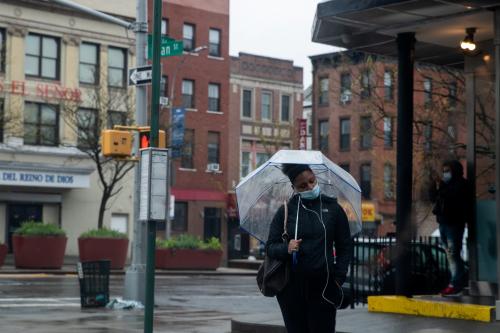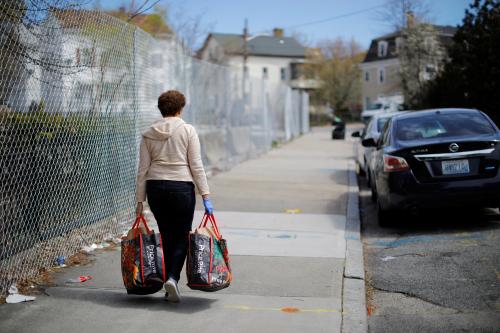A topical trope is that COVID-19 “does not discriminate.” This is false. A range of factors, including the intersecting dimensions of class, race, preexisting health status and geography make some people much more vulnerable. Some are more likely to contract the virus, especially those living in denser urban areas or working in close proximity with others. Existing inequalities in preexisting conditions such as hypertension or diabetes also magnify the impact of the virus.
But there is one very large gap that cannot be easily explained by either of these factors: the gender gap in mortality rates. Men and women have similar odds of contracting the virus, although there is some variation across countries: in some, women make up the majority of cases; in others, men do. But men face a higher risk of death than women, across the U.S. and indeed across the globe. In England and Wales, for example, male social care workers are dying from COVID-19 at a rate of 23.4 deaths per 100,000, compared to a rate of 9.6 for their female peers.
Our colleague Shamika Ravi reports in her paper “COVID-19 trends from Germany show different impacts by gender and age,” that the gap may be growing as the pandemic spreads. As Ravi writes: “Remarkably, the mortality rate of men is rising significantly faster than mortality rate for women in Germany, for all age groups.”
COVID-19, global mankiller
The greater mortality risks for men became apparent early in the early stages of the pandemic, with Chinese men dying at higher rates. As more data from more countries has become available, the pattern has been confirmed. Globally, the risk of contracting COVID-19 is similar for men and women. But the resulting death rates are very different.
“In every country with sex-disaggregated data … there is between a 10% and 90% higher rate of mortality amongst people diagnosed with COVID if they are men compared to if they are women,” Sarah Hawkes, professor of global public health at University College London told CNN on March 24. Prof. Hawkes is co-director of Global Health 50/50, a nonprofit that highlights health inequalities by sex, and is assiduously attempting to aggregate up-to-date COVID-19 figures by sex. Their analyses show that in almost every country reporting mortality data broken by sex available, the risks are higher for men who contract the virus than for women who do. Here we show the gender gap in the ten countries with the highest death tolls at the time of writing:

If rates of contraction are similar among men and women globally (as they appear to be), and assuming, conservatively, a 50% higher mortality rate for men, this means that about 60,000 more men than women have likely died so far (out of the worldwide estimated total of 263,000).
In some countries, data are only readily available for overall death rates among men and women, rather than among those with a confirmed diagnosis. In the U.S. for example, men account for 58% of the reported deaths, according to data from CDC updated on May 6th. In England and Wales and France this figure is 60%; in Malaysia 78%.
The CDC data (as updated on May 6) shows age is a massive risk factor, with the highest death rates occurring among older people. But there is also a gender gap across the age distribution:

This gender gap can be seen more clearly in the ratio of the death rates of men and women within age brackets:

To date, around 5,000 more men than women have died from the virus in the U.S. Across all age ranges, the gender gap in death rates is high – and seems particularly wide for those in middle age. For those aged 45 and 54, there are five men dying for every two women. It is worth noting, however, that more women over the age of 85 have died from the virus, despite having a lower death rate – simply because women make up most of this age group (4.2 million compared to 2.3 million men).
Why are men dying in such greater numbers?
Why the stark gender gap? There is no clear answer. An early theory was that higher smoking rates among men was the cause – based on a big gap on this front in China. But there are similar or even larger gaps in other countries without a big difference in smoking rates between men and women. In fact, there is now some evidence from France that smokers are at a lower risk: a trial is now underway giving non-smokers nicotine patches.
Researchers are investigating a range of possibilities for greater male vulnerability, including certain pre-existing conditions, as well as immunological and hormonal factors. As Prof Hawkes told The Guardian on April 16: “The honest answer is none of us know what’s causing the difference.” Most experts now point to sex differences in the response of the immune system, with men more likely to see their condition worsen. “That [this] seems to be occurring to a significantly greater degree in men than women, it does speak to biology,” Sabra Klein, a microbiologist at Johns Hopkins University, told the Washington Post on April 4.
Adjusting for age, the gender gap widens further
As we noted above, most of the deaths in the U.S. so far have been among the over-75s, according to the CDC. Given that there are fewer older men in the population in the first place, this suggests that the gender gap in mortality may be even starker than some of the headline numbers available from many cities, states and countries might suggest.
We use data from New York City to explore this question, by calculating estimate age-adjusted mortality rates by sex. We have selected NYC because, at the time of writing, it is still the epicenter of the COVID pandemic in the U.S. and because city officials are releasing daily-updated figures on cases, hospitalization and deaths, broken by sex and age (but not, unlike the CDC, by both). In New York the overall male death rate is 1.7 times higher than the female death rate, at 228 per 100,000 and 134 per 100,000, respectively.
But as elsewhere, the death rate among the over-75s is also very much higher than for younger New Yorkers. And about 62 percent of New Yorkers over the age of 75 are women, according to the 2018 Census population estimates. To create an age-adjusted death rates by sex, we first calculate an expected death rate for men and women by multiplying age-specific death rates by age-specific population share for men and women. In other words, we calculate the death rates for men and women given the existing age distribution but assuming no sex difference in vulnerability to COVID-19. The expected death rates for NYC would be 123 per 100,000 for men and 156 per 100,000 for women. We then use these expected death rates to calculate an age-adjusted COVID-19 death rate by gender, by dividing reported death rates for each gender by the expected gender-based death rate we calculated, multiplied by the citywide reported death rate in NYC.
These age-adjusted gender gaps, which account for the fact that there are fewer men in the oldest age groups, show an even bigger disadvantage for men, with a gender ratio of more than 2:1 in death rates (205 per 100,000 compared to 95 per 100,000). In New York City, then, men have slightly higher odds than women of being counted as a COVID-19 case; more risk of being hospitalized; higher overall death rates; and even higher death rates if the age distribution is taken into account:

Sex-disaggregated health data, please
Our analysis is restricted to New York City, but we suspect similar patterns can be observed in other cities, and in other countries. One of the obstacles to this kind of analysis is a lack of data disaggregated by sex. Ironically, it has almost always been advocates for women’s rights fighting for this kind of data, since raw data can often disguise health concerns specific to women. Now the difficulty in compiling this data in many countries in the world, including the U.S., is hindering efforts to understand the way in which COVID-19 is impacting men. Perhaps such a strong male skew this time around will spur policymakers to act on this long-overdue data demand.
Implications of the COVID-19 gender gap
COVID-19 is not unique in its impact on men. There was a gender gap in SARS mortality rates, for example. Men die, on average, five years earlier than women. Gender disparities in health conditions can run in both directions – another reason for better data. But the COVID-19 gap is so stark that it justifies further investigation, and there are some nascent, if modest, efforts to do so.
The gendered impacts of COVID-19 go well beyond immediate health effects, of course, and include trends in the labor market, in rates of domestic violence, in the division of caring responsibilities, and so on. Many of these effects may become stronger in coming months. The main message here is to be constantly attentive to differential impact across a whole range of dimensions, and to collect and present data accordingly.
Faith Smith provided excellent research assistance for this article.
The Brookings Institution is committed to quality, independence, and impact.
We are supported by a diverse array of funders. In line with our values and policies, each Brookings publication represents the sole views of its author(s).








Commentary
COVID-19 much more fatal for men, especially taking age into account
May 15, 2020